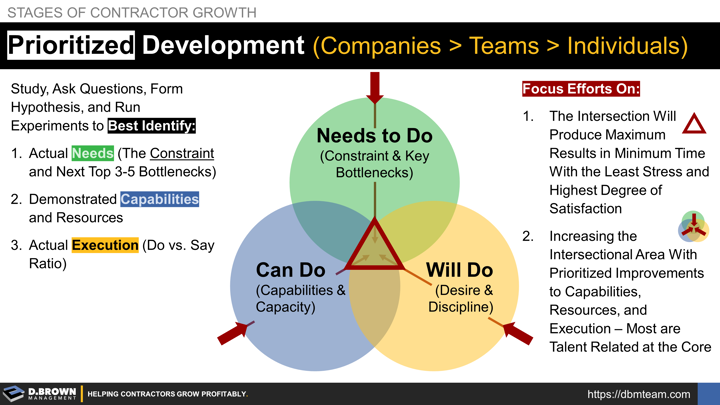IDENTIFYING THE BUSINESS NEEDS
"Seeing" all the problems with systems, gaps in talent development, and possible opportunities is a crucial foundational skillset. Seeing all the details in the environment is the first step in situational awareness.
The first big step in moving from a Project Manager to a Business Manager - or from leading a Stage 2 contractor to a Stage 3+ contractor is shifting the balance in your modes of prioritization.
When managing projects either in the field or as a PM, the core skillset is to (1) see all the details then (2) prioritize how to get them all done. A job that is 99.9% complete gets a punch list handed to you that's pretty long by a less than pleased customer.
When managing a contracting business or a functional area of that business like operations or estimating, the mode of prioritization has to shift. Step 1 is similar.
- See all the details of improvements to things that could go better, development of people starting with yourself, and opportunities in the market that you could chase.
- Prioritize what should get done, to what "Degree of Done" it needs to be, and in what sequence for optimum impact. This means saying 'NO' to many things and applying "Duct Tape & Tie-Wire" fixes to others which is extremely difficult but these are the decisions required of the role.
This will define your "Needs to Be Done" list which should include the constraint (limiting factor) and the next 3-5 bottlenecks behind that constraint.
DIGGNING DEEPER: Study the Theory of Constraints (ToS) starting with this short video and, if applicable, reading or listening to:
Note: an experienced but unbiased 3rd party can be extremely helpful in both structured evaluations to help you "see" all the details as well as rigorous discussions to challenge you and your team to help prioritize a roadmap.
IDENTIFYING WHAT YOU + COMPANY + TEAM CAN DO
If there were zero resource constraints, everything would be easy. :)
Unfortunately, in the real world, there are constraints to all kinds of resources including capabilities (what people can do), their capacity (how much they can do), and capital that can be potentially used to pay for additional resources to develop capabilities or capacity.
The constraint and bottlenecks identified above must be mapped against your organizational resources including the daily operations that are pulling on those same resources.
Remember that in very rare occasions, setting expectations far above someone's current capabilities or capacity will lead to breakthrough performance. In most cases, the outcomes will be delayed completion times and demoralization at best, dangerous or even deadly at worst.
IDENTIFY DESIRE TO DO
If leadership were as easy as sending out a memo clearly outlining expectations then everyone would do it. :)
In the real world, it is important to get buy-in for initiatives, especially those over and above the whirlwind of daily operations.
Frank Blake who is the retired CEO of Home Depot described a simple formula for effectiveness.
E = Q x A
Effectiveness (Return) = Quality (of Idea) x Acceptance (by Team)
Once you have aligned the priorities with the resources for what is optimum sequencing, check that against what the team is thinking. If their ideas on priorities are only 80% as good as yours but they are excited about it, there will likely be a much higher degree of acceptance and execution assuming the capabilities and capacity are there. An 80% idea implemented 90% in 90 days is far more effective than a 100% idea implemented 70% in 180 days.
This is a balance - but know that position power has its limits. The best leaders and managers rarely have to use position power. They socialize their ideas getting widespread input and buy-in before any "decisions" are made.
Once the first constraint and bottlenecks are cleared, there will be more with each stage of contractor growth and ever-changing market conditions.

